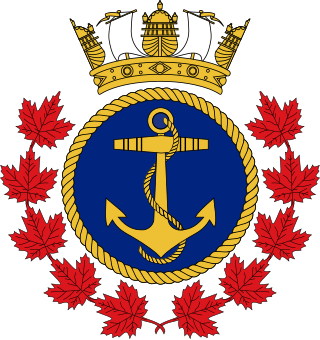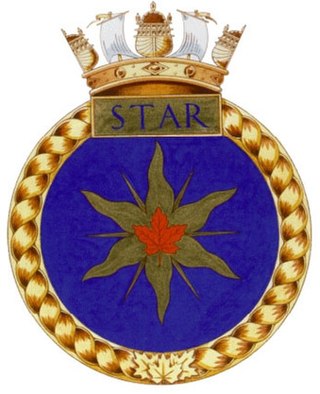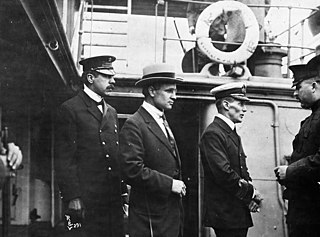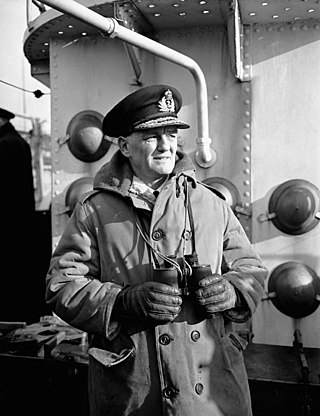
The Royal Canadian Navy is the naval force of Canada. The RCN is one of three environmental commands within the Canadian Armed Forces. As of 2021, the RCN operates 12 frigates, four attack submarines, 12 coastal defence vessels, eight patrol class training vessels, two offshore patrol vessels, and several auxiliary vessels. The RCN consists of 8,570 Regular Force and 4,111 Primary Reserve sailors, supported by 3,800 civilians. Vice-Admiral Angus Topshee is the current commander of the Royal Canadian Navy and chief of the Naval Staff.
The history of the Royal Canadian Navy goes back to 1910, when the naval force was created as the Naval Service of Canada and renamed a year later by King George V. The Royal Canadian Navy (RCN) is one of the three environmental commands of the Canadian Forces. Over the course of its history, the RCN has played a role in the First World War, contributed significantly to the Battle of the Atlantic during the Second World War, and was a part of NATO's force buildup during the Cold War. In 1968, the RCN was amalgamated with the Canadian Army and the Royal Canadian Air Force to form what is today the unified Canadian Armed Forces. The naval force was known as Maritime Command until 2011, when the environmental command was renamed as the Royal Canadian Navy.

USS Argonaut (SS-475) was a Tench-class submarine operated by the United States Navy (USN). Constructed at Portsmouth Navy Yard during the second half of 1944, Argonaut was commissioned into the USN in 1945 and operated during the final year of World War II, although her only contact with the Japanese was when she sank a junk in August. During the 1950s, the submarine was modified for greater underwater endurance, and to guide the Regulus I missile. From 1963 to 1965, Argonaut operated in the Mediterranean Sea.

The Royal Canadian Sea Cadets is a Canadian national youth program sponsored by the Canadian Armed Forces and the civilian Navy League of Canada. Administered by the Canadian Forces, the program is funded through the Department of National Defence, with the civilian partner providing support in the local community. Cadets are not members of the Canadian Armed Forces.

Canadian Forces Base (CFB) Halifax is Canada's east coast naval base and home port to the Royal Canadian Navy Atlantic fleet, known as Canadian Fleet Atlantic (CANFLTLANT), that forms part of the formation Maritime Forces Atlantic (MARLANT).

Admiral John Rogers Anderson, is a retired Canadian Forces officer, former Canadian diplomat and civil servant.
Naval Radio Section Aldergrove, or NRS Aldergrove, is a Canadian Forces naval radio communications facility located in both Aldergrove and Matsqui, British Columbia.

HMCS York is a Royal Canadian Navy Reserve Division (NRD) located in Toronto, Ontario. Dubbed a stone frigate, HMCS York is a land-based naval establishment for part-time sailors as well as a local recruitment centre for the Canadian Naval Reserve.

HMCS Star is a Canadian Forces Naval Reserve Division (NRD) located in Hamilton, Ontario. Dubbed a stone frigate, HMCS Star is a land-based naval establishment for training part-time sailors as well as functioning as a local recruitment centre for the Royal Canadian Navy (RCN). The second oldest of 24 naval reserve divisions located in major cities across Canada, Star was stood up on 15 March 1923 as the Royal Canadian Naval Volunteer Reserve (RCNVR) Hamilton Half Company and then on 1 November 1941 as HMCS Star.

HMCS Malahat is a Royal Canadian Navy Reserve Division (NRD) located in Victoria, British Columbia. Dubbed a stone frigate, HMCS Malahat is a land-based naval training establishment for part-time sailors as well as a local recruitment centre for the Canadian Naval Reserve. It is one of 24 naval reserve divisions in major cities across Canada.

The Naval Reserve is the Primary Reserve component of the Royal Canadian Navy (RCN). The primary mission of the NAVRES is to force generate sailors and teams for Canadian Armed Forces (CAF) operations, including: domestic safety operations as well as security and defence missions, while at the same time supporting the Navy's efforts in connecting with Canadians through the maintenance of a broad national presence.

HMCS Unicorn is a Canadian Forces Naval Reserve division (NRD) located in Saskatoon, Saskatchewan. Dubbed a stone frigate, Unicorn is a land-based naval training establishment crewed by part-time sailors and also serves as a local recruitment centre for the Royal Canadian Navy (RCN). It is one of 24 naval reserve divisions located in major cities across Canada.

Rear Admiral Walter Hose, was an officer of the Royal Navy (RN), the Royal Canadian Navy (RCN) and founder of the Royal Canadian Naval Volunteer Reserve (RCNVR).

Vice-Admiral Harold Taylor Wood Grant, was a Canadian naval officer and a post-war Chief of the Naval Staff. The son of Lieutenant Governor of Nova Scotia, MacCallum Grant, Harold Grant entered the Royal Canadian Navy as a cadet in 1914. He spent most of the First World War in training until 1917, when he became a midshipman aboard a British Royal Navy ship. Considered an above average officer, he was earmarked for early promotion during the interwar period and by 1938, commanded the destroyer HMCS Skeena.
Vice Admiral James Andrew Fulton CMM, CD was a Canadian Forces officer who served as Commander Maritime Command from 6 August 1980 to 29 July 1983.

Vice-Admiral George Clarence Jones, was a Royal Canadian Navy vice admiral who served as Chief of the Naval Staff from 15 January 1944 to 28 February 1946.

Naval Mobile Construction Battalion TWO SIX was a United States Navy Seabee battalion commissioned in 1942 for support to Naval Operations in the Pacific Theater in World War II and later a Reserve Naval Construction Battalion based in various locations in the Midwest from 1962 until 2014.
HMCS Cataraqui is a Canadian Forces Naval Reserve Division (NRD) located in Kingston, Ontario. Dubbed a stone frigate, HMCS Cataraqui is a land-based naval establishment for part-time sailors as well as a local recruitment centre for the Royal Canadian Navy (RCN). It is one of 24 naval reserve divisions located in major cities across Canada.
HMCS Queen Charlotte is a Canadian Forces Naval Reserve Division (NRD) located in Charlottetown, Prince Edward Island. Dubbed a stone frigate, HMCS Queen Charlotte is a land-based naval training establishment crewed by part-time sailors and also serves as a local recruitment centre for the Royal Canadian Navy (RCN). It is one of 24 naval reserve divisions located in major cities across Canada.
Michael Hopper is a Canadian Forces officer who served as commander of the Naval Reserve from July 29, 2018 until 2021. Hopper holds the rank of commodore in the Royal Canadian Navy and also works as a teacher with the Ottawa-Carleton District School Board (OCDSB).














